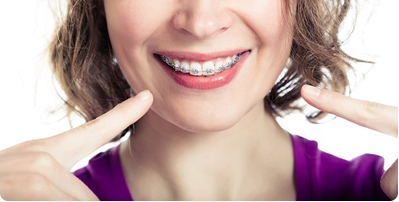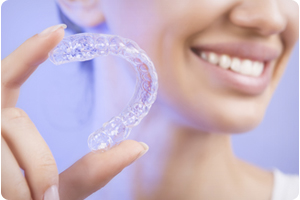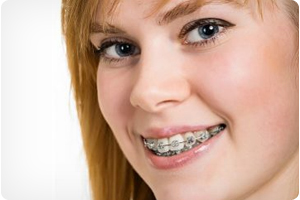Simply put, braces are devices that move your teeth into a straighter or healthier alignment. Patients who wear braces may do so to improve their “orofacial” appearance (in other words, for cosmetic reasons), or they may need to correct a structural deficiency, such as one of the following:

When a patient suffers from one of the above issues, putting off or avoiding braces can eventually lead to more serious problems, including gum disease, tooth decay, increased risk of facial-impact injuries, jaw pain, headaches, ear pain, or difficulties with physical tasks like chewing, biting, or speaking clearly. When braces treatment is performed by an orthodontic specialist, however, these and other potential problems can be resolved before they even have a chance to begin.

There are different types of braces that function in a variety of ways, but they all ultimately perform the same function: they place a small amount of pressure on the specific teeth you want to move. As time progresses, your teeth begin to move gradually in the direction of the pressure. They’re able to move like this because of the elastic “periodontal ligaments” that attach each tooth to your jawbone. These periodontal ligaments allow your teeth to make tiny, tiny movements, and each time a tooth moves, the ligaments and surrounding bone tissue are able to change shape and regrow in order to accommodate each tooth’s new position. You won’t notice the individual, ultra-slow movements, but eventually your teeth will be noticeably straighter and healthier!
Styles of braces can be divided up based on two different categories: their method of placing pressure on your teeth, and the materials from which they are made.
Typically, braces can be made from three different types of materials: metal, ceramic, or plastic. Each material has its own pros and cons, and not every material will be available for every style of braces. Here is a brief overview of each material:
 Metal is the most common and strongest material available for braces. Its strength, in fact, makes metal a great choice for patients who engage in physical activities with a higher risk of facial impact. Metal also tends to be the least expensive option for braces materials. If you are looking into metal braces, you should also consider which type of metal your braces will be. For example, common popular metals today include titanium and stainless steel. If you or your loved one has an allergy to nickel, you should avoid stainless steel (which has nickel in it).
Metal is the most common and strongest material available for braces. Its strength, in fact, makes metal a great choice for patients who engage in physical activities with a higher risk of facial impact. Metal also tends to be the least expensive option for braces materials. If you are looking into metal braces, you should also consider which type of metal your braces will be. For example, common popular metals today include titanium and stainless steel. If you or your loved one has an allergy to nickel, you should avoid stainless steel (which has nickel in it).
 Traditional braces styles that are referred to as “clear” are usually made of ceramic. While the ceramic material isn’t actually see-through, it is specially colored to match your unique tooth color. Thus the overall appearance of ceramic braces makes them look clear. While ceramic is also a strong material for braces, it is not as strong as metal. Ceramic can also be slightly more expensive than metal. In general, ceramic is a great choice for adults who want a more discreet option for straightening their teeth, as well as for children or teens who may feel self-conscious about their appearance and who don’t engage in activities with a higher risk of facial impact (such as football or soccer).
Traditional braces styles that are referred to as “clear” are usually made of ceramic. While the ceramic material isn’t actually see-through, it is specially colored to match your unique tooth color. Thus the overall appearance of ceramic braces makes them look clear. While ceramic is also a strong material for braces, it is not as strong as metal. Ceramic can also be slightly more expensive than metal. In general, ceramic is a great choice for adults who want a more discreet option for straightening their teeth, as well as for children or teens who may feel self-conscious about their appearance and who don’t engage in activities with a higher risk of facial impact (such as football or soccer).
 Plastic is not typically used with the traditional style of braces; rather, it is the material of choice for aligners such as Invisalign. The benefits of plastic include its transparency (which works great for patients who want the ultimate discretion in their treatment) and its ability to be molded to a patient’s specific teeth. The benefits of plastic have more to do with the style of braces that plastic makes possible. You can read more about this in the “Aligners” section below.
Plastic is not typically used with the traditional style of braces; rather, it is the material of choice for aligners such as Invisalign. The benefits of plastic include its transparency (which works great for patients who want the ultimate discretion in their treatment) and its ability to be molded to a patient’s specific teeth. The benefits of plastic have more to do with the style of braces that plastic makes possible. You can read more about this in the “Aligners” section below.
The traditional braces style has been around for centuries, believe it or not! Of course, traditional braces today incorporate numerous advances in technology and materials that make them more comfortable and effective even than braces from 10 or 15 years ago. Traditional braces consist of three main components:

While traditional braces may not be the fastest method available for straightening teeth, they still carry with them certain benefits that make them the treatment style of choice for some patients. Most notable among those potential benefits are their relative inexpensiveness compared to other options, and their ability to treat more severe orthodontic cases that wouldn’t respond well to other options.
 Self-ligating braces follow nearly the same format as the traditional braces described above, with one key difference: they only consist of brackets and an archwire. The term “self-ligating” simply means that these brackets hold onto the archwire by themselves, without the help of rubber bands or ties. The archwire slides directly through each bracket and is secured in place with a clip or “door.” This self-ligation means that, in some cases, the archwire’s pressure on the brackets can be auto-adjusted without a trip to the orthodontist. The benefits of self-ligating braces include shortened overall treatment time, fewer trips to the orthodontist, and (in the case of ceramic braces) better discretion thanks to the lack of rubber bands or ties.
Self-ligating braces follow nearly the same format as the traditional braces described above, with one key difference: they only consist of brackets and an archwire. The term “self-ligating” simply means that these brackets hold onto the archwire by themselves, without the help of rubber bands or ties. The archwire slides directly through each bracket and is secured in place with a clip or “door.” This self-ligation means that, in some cases, the archwire’s pressure on the brackets can be auto-adjusted without a trip to the orthodontist. The benefits of self-ligating braces include shortened overall treatment time, fewer trips to the orthodontist, and (in the case of ceramic braces) better discretion thanks to the lack of rubber bands or ties.
 As with self-ligating braces, lingual braces also follow the same overall principle as traditional bracket and wire braces. The major difference here is that these brackets are placed onto the backs of your teeth rather than the front. Lingual braces are an ideal choice for professionals who need the ultimate discretion while they straighten their teeth.
As with self-ligating braces, lingual braces also follow the same overall principle as traditional bracket and wire braces. The major difference here is that these brackets are placed onto the backs of your teeth rather than the front. Lingual braces are an ideal choice for professionals who need the ultimate discretion while they straighten their teeth.
 Most orthodontic offices refer to their aligner options by brand name. Two common brand names that you may see offered are Invisalign and ClearCorrect, although there are others as well.
Most orthodontic offices refer to their aligner options by brand name. Two common brand names that you may see offered are Invisalign and ClearCorrect, although there are others as well.
Aligners are the one style on this list that differs dramatically from the rest. In fact, it is technically incorrect to refer to them as “braces,” since they don’t have any brackets (the synonym for “braces”). While all of the braces options listed above are semi-permanently attached to your teeth, aligners fit over your teeth much in the same way a mouthguard or retainer would, and you can remove them anytime you like.
Using an advanced computer program combined with a scan or mold of your teeth, your orthodontist will have multiple aligners custom made just for you. Each aligner represents a different step in the overall path that your teeth will follow as they move into place. You will wear each aligner for 5 to 14 days, after which you will throw it out and replace it with the next aligner.
In addition to discreet treatment thanks to the clear plastic material, the benefits of aligners largely involve the ability to avoid many of the hassles that come from bracket-style braces. For example, the removable aligners simplify teeth brushing, allow you to eat anything you want, and don’t chafe the inside of your mouth.
However, aligners do come with some cons, most notably their ability to be misplaced or accidentally thrown away. Aligners aren’t always an appropriate option for more advanced cases. Your orthodontist can discuss more of the pros and cons of aligners vs. braces as they pertain to your individual situation.
Your Top Rated & Favorite Orthodontists